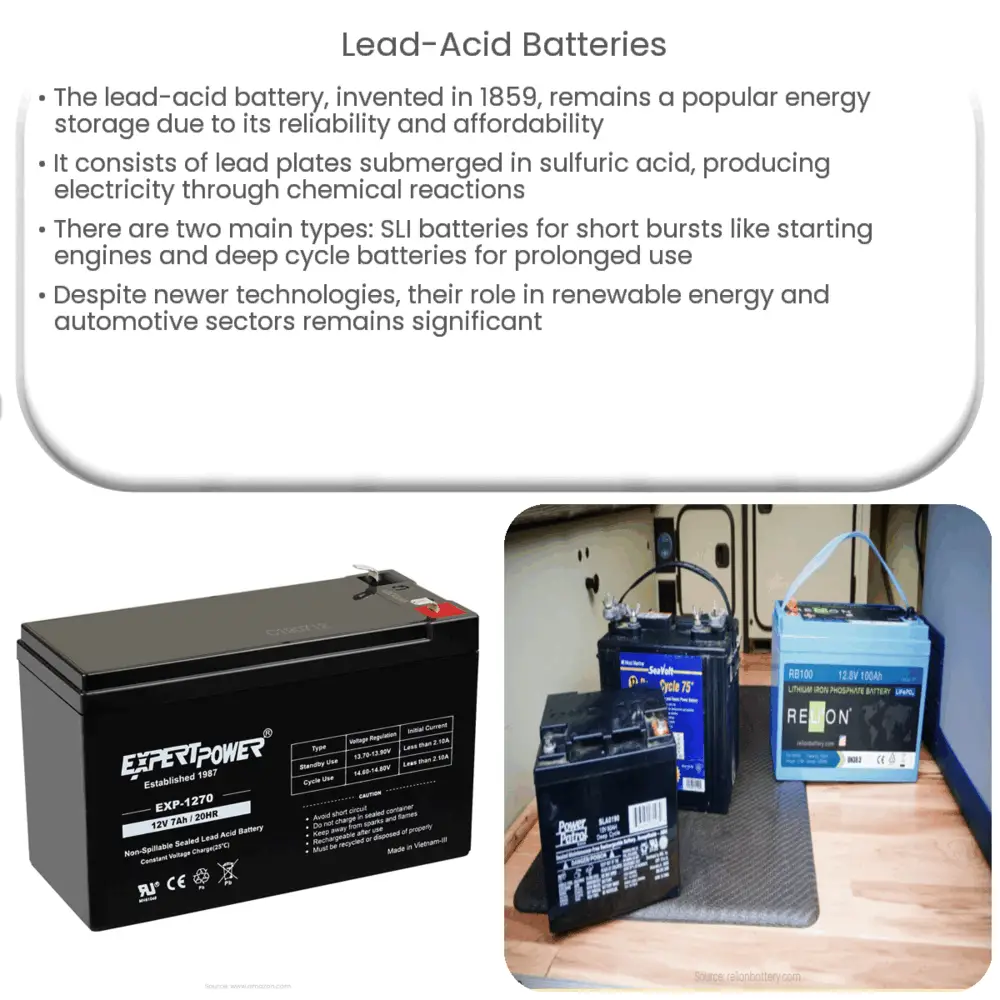Explore the world of lead-acid batteries: their structure, operation, types, pros & cons, maintenance, and their future prospects.

Introduction to Lead-Acid Batteries
The lead-acid battery, invented in 1859 by the French physicist Gaston Planté, is the oldest type of rechargeable battery. Over a century and a half after its creation, it continues to be a widely used energy storage system due to its reliability and low cost.
Structure and Composition
A lead-acid battery is composed of a series of cells, each of which includes two types of lead plates – one coated with lead dioxide and the other made of sponge lead – submerged in a sulfuric acid solution. This sulfuric acid solution, also known as electrolyte, acts as a catalyst to prompt the chemical reaction that produces electricity.
- Lead dioxide plate: This is the positive electrode or anode. The lead dioxide (PbO2) is typically applied to a grid made of pure lead or a lead alloy to create a plate.
- Sponge lead plate: This is the negative electrode or cathode. It’s also mounted on a lead or lead-alloy grid, but instead of lead dioxide, it’s coated with a thin layer of “sponge” lead, a porous form of pure lead.
- Sulfuric acid solution: This electrolyte is a mixture of sulfuric acid (H2SO4) and water. The acid reacts with the lead plates to generate electricity.
Working Principle of Lead-Acid Batteries
The lead-acid battery generates electricity through a chemical reaction. When the battery is discharging (i.e., providing electrical energy), the lead dioxide plate reacts with the sulfuric acid to create lead sulfate and water. Concurrently, the sponge lead plate also reacts with the sulfuric acid, producing lead sulfate and releasing electrons. These freed electrons create an electric current that can be used to power devices.
Types of Lead-Acid Batteries
Lead-acid batteries come in various forms, each suited to specific applications. The two main types are:
- Starting, Lighting, and Ignition (SLI) batteries: These batteries deliver short, high-current bursts for starting an engine and then are rapidly recharged. They are commonly found in vehicles.
- Deep Cycle batteries: These batteries are designed to discharge between 60% and 80% of their capacity over longer periods, making them ideal for applications such as electric wheelchairs, marine applications, or renewable energy systems.
Advantages and Disadvantages of Lead-Acid Batteries
Lead-acid batteries have certain advantages that contribute to their wide use:
- Cost-effectiveness: They are relatively inexpensive to manufacture and maintain, making them a cost-effective solution for many applications.
- High surge current: The ability of these batteries to supply high surge currents means that the cells have a relatively large power-to-weight ratio, which is crucial in applications like starting a car engine.
- Reliability: Lead-acid batteries are reliable and can function in a wide range of temperatures and conditions.
However, they also have some disadvantages:
- Weight: These batteries are quite heavy due to the lead content, which can limit their use in portable applications.
- Environmentally unfriendly: Lead is a toxic material, and thus the batteries need careful disposal. Although recycling programs exist, these are not always available or adequately used.
- Short life span: Despite being rechargeable, lead-acid batteries have a relatively short lifespan compared to other rechargeable batteries, like lithium-ion ones.
Maintenance of Lead-Acid Batteries
Proper maintenance is key to prolonging the lifespan of lead-acid batteries. Overcharging or undercharging can lead to decreased efficiency and capacity. Regularly checking and adjusting the electrolyte levels, keeping the battery clean, and ensuring it’s charged correctly can help keep the battery operating at its best.
Future of Lead-Acid Batteries
Despite their age and the emergence of newer technologies, lead-acid batteries still have a significant role to play in our future, particularly in renewable energy systems and automotive applications. Innovations and improvements in battery technology are being continuously researched to increase their efficiency, capacity, and lifespan.
Conclusion
In conclusion, lead-acid batteries have played a pivotal role in the evolution of energy storage systems since their invention in the 19th century. While they come with certain drawbacks, their cost-effectiveness, reliability, and ability to deliver high surge currents continue to make them a popular choice. As technology evolves, we can expect to see even more efficient and durable lead-acid batteries playing a critical role in a diverse range of applications.

